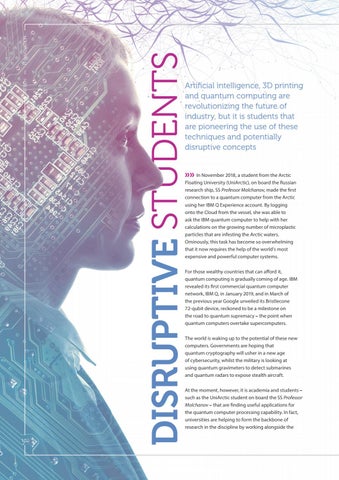IT INNOVATION NITECH ›››
Artificial intelligence, 3D printing and quantum computing are revolutionizing the future of industry, but it is students that are pioneering the use of these techniques and potentially disruptive concepts
In November 2018, a student from the Arctic Floating University (UniArctic), on board the Russian research ship, SS Professor Molchanov, made the first connection to a quantum computer from the Arctic using her IBM Q Experience account. By logging onto the Cloud from the vessel, she was able to ask the IBM quantum computer to help with her calculations on the growing number of microplastic particles that are infesting the Arctic waters. Ominously, this task has become so overwhelming that it now requires the help of the world’s most expensive and powerful computer systems. For those wealthy countries that can afford it, quantum computing is gradually coming of age. IBM revealed its first commercial quantum computer network, IBM Q, in January 2019, and in March of the previous year Google unveiled its Bristlecone 72-qubit device, reckoned to be a milestone on the road to quantum supremacy – the point when quantum computers overtake supercomputers. The world is waking up to the potential of these new computers. Governments are hoping that quantum cryptography will usher in a new age of cybersecurity, whilst the military is looking at using quantum gravimeters to detect submarines and quantum radars to expose stealth aircraft. At the moment, however, it is academia and students – such as the UniArctic student on board the SS Professor Molchanov – that are finding useful applications for the quantum computer processing capability. In fact, universities are helping to form the backbone of research in the discipline by working alongside the 102
